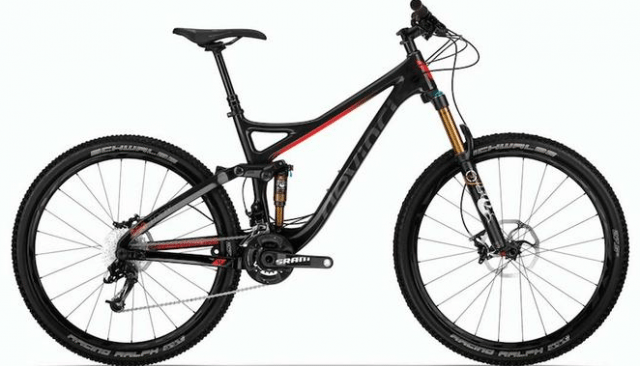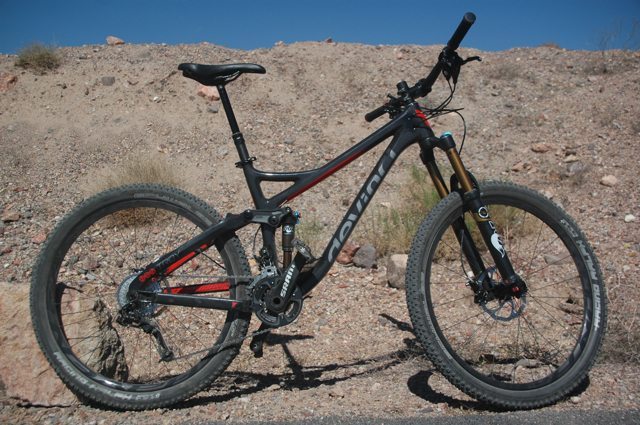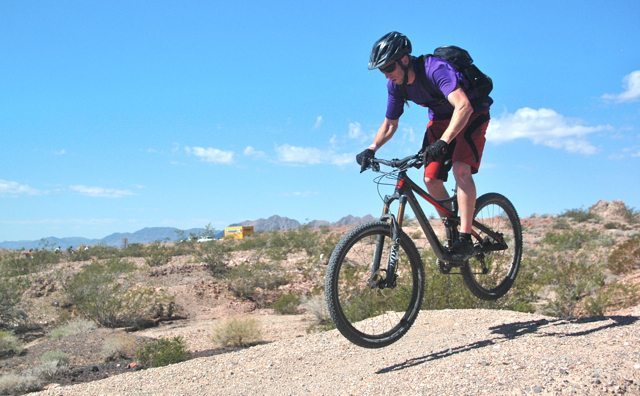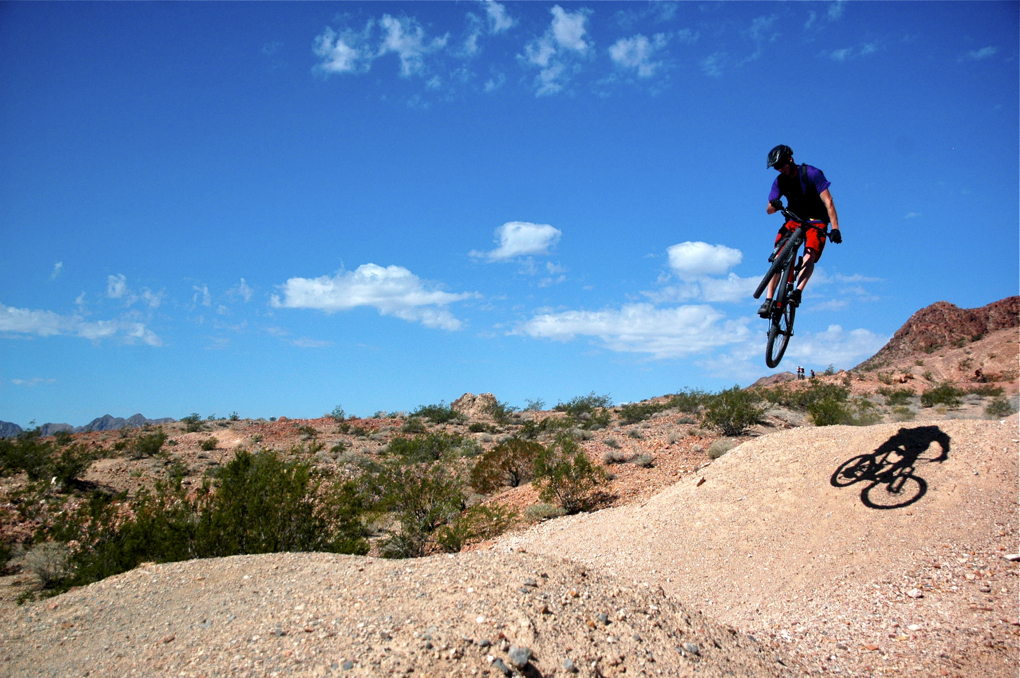
2014 Devinci Troy Carbon SL
Frame: Carbon DMC-G
Size Tested: Medium (23.9″)
Wheels: 27.5″
Travel: 140mm
Rider Info: 5’9”, 150 lbs.
The Build
- Fox Float CTD Adjust Factory Series
- Fox Float 34 CTD FIT 140mm Factory Series
- SRAM x.0 T2
- Avid Elixir 9 Trail
MSRP: $6,499
Days Tested: 1
Test Location: Bootleg Canyon, Boulder City, Nevada
The Caveat
We just got back from two days of testing bikes on the rocky trails around Boulder City, Nevada, during the annual Interbike Outdoor Demo. We’ll roll out First Looks of other bikes during the next week (including the Pivot Mach 6 and the GT Fury), so stay tuned. But before we get to our initial impressions of the Troy, an important caveat:
(And if you’ve already read the intro to the review of the Devinci Atlas, feel free to skip this part and scroll down to First Impressions.)
Riding bikes at a demo is always kind of tricky. For starters, we didn’t get much time on each bike—at most around an hour, and with many bikes it was just a 25-minute loop. 25 minutes can tell you a lot about how a bike handles, but it certainly doesn’t allow for the customary in-depth, BLISTER analysis.
In addition, these bikes are set up by mechanics at each company’s booth, and while these guys do a great job, there isn’t really time to get each bike dialed for how I’d normally set it up. (If nothing else, I probably would have put wider bars on most of the bikes I rode.)
And then there are the trails. Interbike’s Outdoor Demo takes place at Bootleg Canyon in Boulder City. It’s a little bastion of awesomeness that overlooks the pit of despair that is Las Vegas, and the trails are fantastic: super rocky, with lots of sand, some rocks, some jumps here and there, and did I mention the rocks? Most of my time on these bikes was spent on the more cross-country oriented trails, even though the DH trail system is (in my opinion) the crown jewel of the Bootleg trail network.
The XC trails have a good mix of flowy corners, short punchy climbs, rock gardens, and a bit of chunder. All in all, they’re decent for testing out the different aspects of a given bike, but to really develop a feel for how a bike works, there’s no substitute for riding it for a long time on a lot of different types of trails.
So with all that in mind, let’s talk about the Devinci Troy.

First Impressions
Devinci made a bit of a splash by debuting the new Troy model at Crankworx this year, where Stevie Smith rode it to a win in the Air DH race down A-Line. For those of you who don’t pay attention to that sort of thing, the Troy is a sexy bit of carbon fiber, sporting 27.5″ wheels and 140mm of travel via a split pivot suspension design.
Devinci still has the 26″ wheeled Dixon in their lineup, and while it only has 5mm more travel than the Troy, it’s a bit slacker (66.2 degree head angle on the Dixon vs. 67 degrees on the Troy). There were also rumors coming out of Crankworx of a longer-travel prototype, so it seems likely that the Troy is set to reign as Devinci’s mid-travel trail bike. I’d speculate that the Dixon is slated for significant revision or possibly replacement.
I rode the Troy SL, which is spec’d with a SRAM XO group and Fox Float CTD shocks front and rear. And while I didn’t get to spend much time on the bike, those parts all worked pretty well. The newer 2014 CTD forks are a vast improvement over the 2013 Float CTD that I reviewed previously. That said, I still miss having a full range of adjustments; even with the new compression settings, I didn’t find the shocks (both front and rear) to feel just right.
But on to the point—the Troy. The Troy is a very capable bike, but I found myself wanting it to be a little more bike. I wanted to treat the Troy like a mini-DH bike, and while I found that it can handle the abuse, the fact remains that it’s really not built for it.
I don’t want this to come across as a negative. The Troy is an awesome bike, and it will completely destroy trails. You can take it on terrain beyond what it’s really meant for, and it’ll go along with you fairly willingly.
When I say I wanted a little more bike, I mean that when I’m looking at a bike in the 140-160mm travel range, I’m looking for a bike that’s extremely capable on the descents. That capability is probably, to some extent, going to come at the expense of climbing prowess, and I’m okay with that. I’m looking for something pretty low and pretty slack that likes to be ridden fast through rough terrain.
And like I said, the Troy will do that kind of riding if that’s what you want, but it doesn’t feel like it’s made with that sort of terrain in mind. Rather, it’s scaled back a notch from a descent-oriented trail destroyer. It doesn’t have that “low flying cruise missile” stability that I like so much.
To some extent, I think Devinci’s marketing is to blame here. By the numbers, I would have guessed that the Troy would ride just like it does—as a good all-around trail bike. But Devinci calls it the “Trojan Horse,” and Stevie Smith went really fast on it, both of which left me with the impression that this thing was meant to go up against some of the longer-travel options out there. I wanted this to be a lightweight trail bike that descended like a slightly scaled down DH bike. But its not; it’s an excellent trail bike, but it definitely doesn’t rise to the “mini-DH bike” category.
Now, while the Troy isn’t as cruise missile-ish, that also means that it’s a good bit more playful, especially at low speeds. Where some bikes don’t really “work” until you get up to speed, the Troy is fine when you’re navigating your way slowly through a rocky minefield.

Suspension
Like all of the full suspension Devincis, the Troy uses the split pivot rear end, which means it has pretty short chainstays (430mm / 16.9″). Those short stays make for a fun ride that’ll flick into corners and make it easy to loft the front wheel over whatever happens to be in front of you.
Like I noted in the Atlas review, a primary selling point of the split pivot is that it performs well under hard braking. While I’ve ridden other split pivot bikes and I know this to be true, the loop that I rode the Troy on wasn’t really conducive to testing out the suspension’s braking performance.
In terms of bump compliance, the Troy’s suspension seemed fairly well composed. I didn’t notice it to sink too deeply into its travel on g-outs or hard corners, but I did notice that, when set up at the proper sag, I bottomed it out pretty hard several times. Granted, these were landings where bottoming out is par for the course, but the Troy bottomed out harder than I would have expected it to.
When it comes to pedaling efficiency, the Troy is similar to most other split pivot bikes I’ve ridden—it’s okay, but not great. Any bobbing can definitely be remedied by putting the shock into climb mode, but the design of the suspension doesn’t inherently make for a super efficient ride. If you really want an efficient pedaling bike and you are morally opposed to flipping levers, there are better options out there.

Bottom Line (For Now)
I think the Troy is a great bike if you’re looking for a true all-arounder. The Troy is definitely a bit more efficient and willing to tackle XC-ish terrain than some of it’s longer-legged competitors, but it gives up some ground when it comes to really gnarly descents.
If you’re coming from a shorter travel bike, and you’re looking to step it up a bit and get your rad on without going totally overboard, the Troy is definitely worth a look. And if you’ve been riding longer travel bikes and you find them to be a bit too piggish for your personal preference, the Troy might be your answer.

what other ‘options’ pedal better than DW link? Its always considered one of the best pedaling platforms out there…
Just to make sure we’re on the same page – the Troy is a Split Pivot design, not a DW-Link. They’re designed by the same guy (Dave Weagle), but they’re quite different.
You’re definitely correct though – the DW link bikes are some of the best pedaling bikes out there. As for other options, the VPP bikes also do a great job when they’re set up correctly (the Santa Cruz Bronson that I rode at interbike pedaled really well).
Of course, there’s lots of other things that affect how a bike pedals aside from just the basic suspension layout. The details of the pivot placement, suspension setup, and the gearing you’re running can all affect the pedaling efficiency of the bike.
Great review Noah. Just curious, other reviews have commented on sizing issues in on the Troy and in particular the top tube. Just wondering if you noticed anything? Also, would the dh improve with the now available as an option float-x?
Also, may I request you review the Norco Sight Carbon.
Thanks, love the site!
The Troy XP, RC or RR models with 150 up front, more aggressive tires, wider bars, etc. may provide a “little more bike”.
hi there
i need a help with sizing. i´m not the tallest. i´m 5.7. so i am better with a small or with a medium troy 2015?
thank you